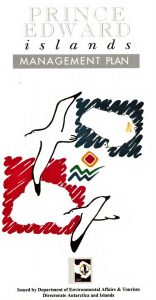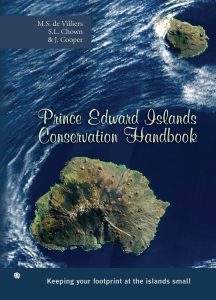A ‘Conservation handbook ‘ (booklet), and ‘Management Plan for the Prince Edward Islands’ and ‘An Introductory guide to the Marion and Prince Edward Island Special Nature Reserves’ are available on the Antarctic Legacy of South Africa archive. Also preserved on the repository are the Prince Edward Island Management Committee meetings – these documents were made available by John Cooper – Collaborator of ALSA.
Situated some I 600 km south-east of Cape Town, the Prince Edward islands are isolated by the vast, inhospitable sou them Indian Ocean. South Africa not only exercises undisputed sovereignty over the two Islands (Marion and Prince Edward) of the group, but is also responsible f’or their environmental well-being and for that of the surrounding exclusive Economic Zone. Such responsibility carries with it the need to both understand and protect the bio-geographic and biotic features which make the Islands unique.
 The Management Plan attempts to ensure that the necessary
The Management Plan attempts to ensure that the necessary  protection is afforded to the Islands’ fragile ecosystems, within the context of both national and international legal obligations, while facilitating the scientific research necessary: to underpin its effective implementation. The Plan constitutes a milestone in that it is attached to the first proclamation of a Special Nature Reserve under the Environment Conservation Act (Act No 73 of 1989).
protection is afforded to the Islands’ fragile ecosystems, within the context of both national and international legal obligations, while facilitating the scientific research necessary: to underpin its effective implementation. The Plan constitutes a milestone in that it is attached to the first proclamation of a Special Nature Reserve under the Environment Conservation Act (Act No 73 of 1989).
 The conservation handbook is a handout to people who are going to the PEIs as part of a research, conservation or weather-monitoring programme there, or to provide essential logistical support for such programmes, or to provide media coverage for events at the islands. This is not a tourist destination – no onshore tourism is allowed at the Prince Edwards in terms of its status as a Special Nature Reserve. The Prince Edward Islands Management Plan provides detailed guidance on environmental practice at the PEIs and should be read by every visitor to the islands. The conservation handbook(booklet) summarises the information in the management plan that is of most relevance. This information will help to minimise human impacts on the islands, and help protect these islands amazing animals, plants and natural systems. This booklet will help to keep the human footprint at the islands as small as possible.
The conservation handbook is a handout to people who are going to the PEIs as part of a research, conservation or weather-monitoring programme there, or to provide essential logistical support for such programmes, or to provide media coverage for events at the islands. This is not a tourist destination – no onshore tourism is allowed at the Prince Edwards in terms of its status as a Special Nature Reserve. The Prince Edward Islands Management Plan provides detailed guidance on environmental practice at the PEIs and should be read by every visitor to the islands. The conservation handbook(booklet) summarises the information in the management plan that is of most relevance. This information will help to minimise human impacts on the islands, and help protect these islands amazing animals, plants and natural systems. This booklet will help to keep the human footprint at the islands as small as possible.

